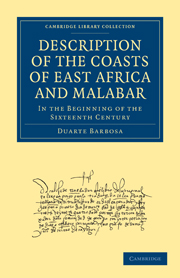TRANSLATOR'S PREFACE
Published online by Cambridge University Press: 07 September 2010
Summary
The Spanish manuscript from which this volume has been translated is in the handwriting of the beginning of 1500, full of abbreviations, and without punctuation or capital letters at the beginnings of sentences or for the proper names, which adds much to the difficulty of reading it. It contains eighty-seven leaves. The handwriting more resembles an example of the year 1510 than those dated 1529 and 1531, given at p. 319 of the “Escuela de Leer Letras Cursivas Antiguas y Modernas desde la entrada de los Godos en España, por el P. Andres Merino de Jesu Christo, Madrid, 1780.” This work was translated into Spanish from the original Portuguese in 1524, at Vittoria, by Martin Centurion, ambassador of the community of Genoa, with the assistance of Diego Ribero, a Portuguese, cosmographer and hydrographer to his Majesty Charles V. There are reasons (as will be shewn in the notes) for supposing that the Spanish translation, probably this copy and not the Portuguese original, assisted the compilers of the early atlases, especially that of Abraham Ortelius, of Antwerp, 1570, other editions of which were published in succeeding years. The similarity of the orthography of this manuscript and of that of the names in maps as late as that of Homann, Nuremberg, 1753, shews how much geography up to a recent period was indebted to the Portuguese and Spaniards. It may ateo be observed that from thenfamiliarity at that time with the sounds of Arabic, the proper names are in general more correctly rendered in European letters, than used to be the case in later times.
- Type
- Chapter
- Information
- Description of the Coasts of East Africa and MalabarIn the Beginning of the Sixteenth Century, pp. iii - xiiiPublisher: Cambridge University PressPrint publication year: 2010First published in: 1866



